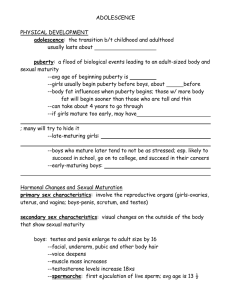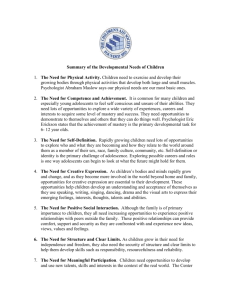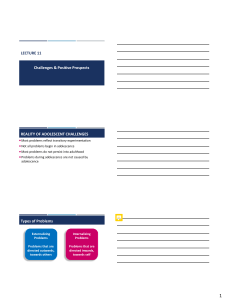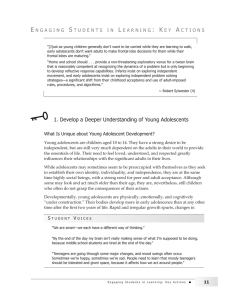Infancy and Childhood
advertisement
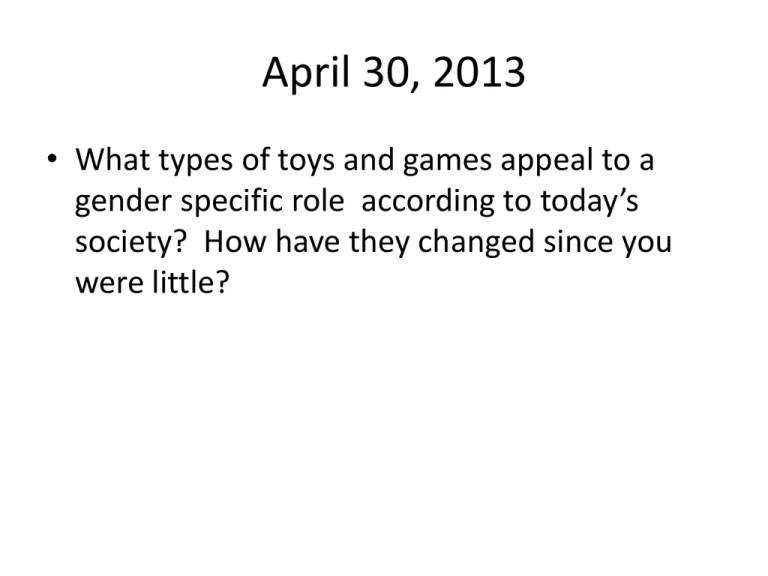
April 30, 2013 • What types of toys and games appeal to a gender specific role according to today’s society? How have they changed since you were little? Infancy and Childhood Chapter 10 and 3 Physical, Perceptual, and Language Development • Developmental Psychology – study of how an individual’s physical, social, emotional, moral, and intellectual development • Study the Following: – Continuity versus stages of development – Stability versus change – Nature vs. Nurture Newborns • Development begins long before an infant is born – Capable of certain inherited, automatic, coordinated movement patterns called reflexes – Grasping Reflex – response to a touch on the palm of the hand – Rooting Reflex – infants response to turn toward the source of touching that occurs around his or her mouth Physical Development • Average weight = 7.5 pounds at birth • Maturation – Internally programmed growth • We all learn at our own rates • No amount of coaching will get a child to do something before it is ready The Development of Language • How Children Acquire Language – Some Psychologists argue that language is reinforced behavior, while others claim it is inborn – First Year • Average child makes many sounds • Late in the first year the babble sounds like the language the child hears – 2 years old – Vocabulary consists of about 50 words – 18 months to 5 years old • Children add 5 to 10 words a day to their vocabulary – 4 to 5 years old • Several thousand words in their vocabulary The Development of Language • Telegraphic Speech – verbal utterances where words are left our but the meaning is usually clear – Where my apple – Daddy fall down – Cat gone The Case of Genie an·thro·pol·o·gy . The scientific study of the origin, the behavior, and the physical, social, and cultural development of humans. developmental psychologynThe branch of psychology concerned with the study of progressive behavioral changes in an individual from birth until death. lin·guist 1. A person who speaks several languages fluently. 2. A specialist in linguistics. so·ci·ol·o·gy The study of human social behavior, especially the study of the origins, organization, institutions, and development of human society. neu·ro·psy·chol·o·gy The branch of psychology that deals with the relationship between the nervous system, especially the brain, and cerebral or mental functions such as language, memory, and perception. psy·cho·ther·a·py (s k -th r -p ) n. pl. psy·cho·ther·a·pies The treatment of mental and emotional disorders through the use of psychological techniques designed to encourage communication of conflicts and insight into problems, with the goal being relief of symptoms, changes in behavior leading to improved social and vocational functioning, and personality growth. Cognitive Development • Jean Piaget – Intelligence or the ability to understand, develops gradually as the child grows • Object Permanence – Even if the object is “gone” it’s still real – Infant = Hide a toy the child thinks it’s “gone” – 7 to 12 months = Hide a toy under a blanket they will look under the blanket – 12 to 18 months = Watches you closely and searches for the toy in the last place they saw it Experiments with Animals • Imprinting – Baby Geese • A few hours after they struggle out of their shells goslings waddle after the first thing they see move (usually mom) • Imprinting is important for survival purposes Parenting Styles • Authoritarian Families – Parents are the bosses - period • Democratic Families – Children Participate in decisions that affect their lives • Permissive Families • Children have the final say • Parents are not solely responsible for the way children turn out – Who is? Child Abuse • Child Abuse – physical, mental, sexual, negligent, or mistreatment of children under the age of 18 by adults who have been entrusted with their care • Reasons For Child Abuse – Many abusive parents were mistreated as children – Overburdened and stressed parents Social Development • Socialization – to live with other people children have to learn what is considered acceptable and unacceptable behavior – Society encourages boys to express aggression but not fear – Girls have been raised to express emotions but not ambitions Erikson’s Theory of Psychosocial Development • Psychosocial Development – Life periods in which an individual’s goal is to satisfy desires associated with social needs – Example: A 2 year old is applauded for mastering a task then he will develop a sense of independence • At the same time if he is punished or ignored he may doubt his achievement Kohlberg’s Stages of Moral Development • Stage 1 – Children do not consider other people’s points of views and have no sense of right or wrong • Stage 2 – Know how to receive rewards as well as to avoid punishment • Stage 3 – Children become sensitive to what other people want and think Kohlberg’s Stages of Moral Development • Stage 4 – Children are less concerned with the approval of other and more about law and order • Stage 5 – Concerned with whether a law is just and fair and believes that laws must change as the world changes Adolescence Chapter 4/ Physical and Sexual Development • Adolescence – transition period between childhood and adulthood – American Society views adolescence as a time of preparation for adult responsibilities – Rites of Passage • Birthdays – 16, 18 and 21 • Bar Mitzvahs Physical Development • Puberty is the biological event that marks the end of childhood – Girls start to mature physically as early as 8 – Boys start to mature at age 9 or 10 • Just before puberty boys and girls experience a growth spurt – Girls begin between 10 and 14 – Boys begin between 11 and 16 Reactions to Growth • When Adolescents talk about what they don’t like the most about themselves they usually talk about physical appearance – How has media helped this idea? Sexual Development • Increase in sexual awareness and activity of teens has raised many questions over the role of family, religion, and government – 1 million pregnancies occur each year among adolescents • Studies show children of teenage mothers are more likely to become teenage mothers themselves, do poorly in school, and serve time in prison – 2 million cases of STDs Personal Development • During Adolescence a sense of identity and self-esteem are very important and depend a lot on friends • Rationalization – seek to explain unpleasant emotions or behavior – You fail a test – you rationalize why you failed the test – Less than half of 17 year olds have reached this stage one study found Personal Development • Some problems adolescents develop as a result of immaturity – Finding fault with authority figures – Argumentativeness – Indecisiveness – Apparent Hypocrisy – Self-Consciousness – Invulnerability Erikson’s Theory of the Identity Crises • Identity Crisis – time of inner conflict during which they worry intensely about their identities – Children tend to live in the present – adolescents begin to think about the future The Role of the Family • Before 1970 the typical American family had a wage earning father who worked outside of the home and a mother who worked in the home • Today – Almost half of all marriages end in divorce, more than half of all adult women are in the workforce, typical family has two wage earners The Role of Peers • High Schools are important places for adolescents get together • Early in adolescence groups are determined by sex but later the sexes mix • Peers set the standards on such matters as fashion and taste in music Difficulties During Adolescence • Natural and normal that adolescents experience some temporary psychological difficulties – Most adjust fairly quickly • Troubled adolescents do not “outgrow” their problems but carry them through life if not treated Teenage Depression and Suicide • Events that trigger depression = loss of a loved one through separation, family relocation, divorce, or death • Depressed teens may appear to be extremely angry – Best way to deal with a depressed teen is to communicate – If the teen is not willing to talk to the parent or family member then professional help is needed Eating Disorders • Anorexia Nervosa – refusing to eat and not maintaining weight – Adolescents see themselves as fat even if they are thin – Treatment – focusing on encouraging weight gain and dealing with the psychological problems • Bulimia Nervosa – Binge eating followed by purging – vomiting, using laxatives etc. – Treatment – therapy and antidepressant drugs Gender Roles and Differences • Parents dress baby girls in pink and boys in blue and give them gender specific names and expect them to act differently • Gender Identity and Gender Roles are two different things – Gender Identity – physical and biological makeup – Gender Role – defined by society and culture Gender Roles • Men are traditionally viewed as dominant, competitive and emotionally reserved • Women are traditionally viewed as submissive, cooperative, and emotional responsive • Gender Stereotypes – prejudiced opinions and attitudes concerning the way men and women should behave Gender Differences • Personality – Differences in males and females do exist – Males are more confident than females • Academic areas such as math or science – Females engage in more verbal aggressive acts while males participate in more physical aggression – Who talks more? • Men talk more than women and interrupt women more while they are talking • Women are more sensitive to nonverbal cues Origins of Gender Differences • Psychoanalytical Theory – Freud • When a child identifies with a parent of the same sex gender identity results • Social Learning Theory – Children learn their gender roles by observing and imitating models such as parents, friends, teachers, etc. • Cognitive Developmental Theory – Children acquire gender roles by interacting with their environment and thinking about those experiences Changing Gender Roles • Before 1960 – Few women sought careers • Mid-80s – Most women had jobs outside of the home • However. . . – Women do not advance as quickly as men – Women occupy lower levels of leadership positions – Women interrupt their careers for child care and miss opportunities for promotion and salary increases


